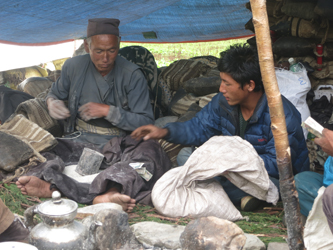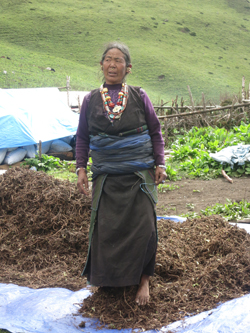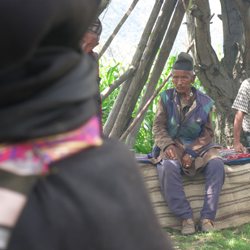Fieldwork in Far West Nepal and Beyond


 My field research focused on the Humli-Khyampa, a group of peripatetic traders, of Tibetan derivation, who migrate through the Far Western Nepali Himalayas from Tibet to the Indian border. Here, in the context of their trading relationships, I studied the chains of value that were enacted through the Khyampa’s economic and ritualistic systems of exchange. For as long as the elders can remember, the Khyampa have bartered Tibetan salt for rice grown by villagers in the fertile valleys of the Nepali Middle Hills. A trade that still continues today, but which is augmented by the Khyampa’s involvement in the highly lucrative medicinal herbs business, and, subsequently, a more monetised form of economic exchange. Most interesting was how mundane products such as rice, roots, and salt acted as mediators in complex systems of inter-ethnic trade. As well as this, I was intrigued by how an organic root which is gathered from high inter-montane valleys, is quickly transformed into a saleable commodity. Furthermore, that due to ever increasing chains of value, each stage of the trading process raises the financial, symbolic, and medicinal value/power of the plant.
My field research focused on the Humli-Khyampa, a group of peripatetic traders, of Tibetan derivation, who migrate through the Far Western Nepali Himalayas from Tibet to the Indian border. Here, in the context of their trading relationships, I studied the chains of value that were enacted through the Khyampa’s economic and ritualistic systems of exchange. For as long as the elders can remember, the Khyampa have bartered Tibetan salt for rice grown by villagers in the fertile valleys of the Nepali Middle Hills. A trade that still continues today, but which is augmented by the Khyampa’s involvement in the highly lucrative medicinal herbs business, and, subsequently, a more monetised form of economic exchange. Most interesting was how mundane products such as rice, roots, and salt acted as mediators in complex systems of inter-ethnic trade. As well as this, I was intrigued by how an organic root which is gathered from high inter-montane valleys, is quickly transformed into a saleable commodity. Furthermore, that due to ever increasing chains of value, each stage of the trading process raises the financial, symbolic, and medicinal value/power of the plant.
From top right:
Gori opens his Lukal (saddlebag) from which he tips Tibetan salt into his lap. To measure the quantity, Gori still uses the same tin container that he used when Khyampa trade was organised through a system of barter. This is illustrative of the ease with which the Khyampa moved from an economy predominantly based around the barter of salt for rice, to one that also employs the use of money. Gori pays close attention to the two five hundred rupee bank notes that have fallen from the buyer’s hand. Waiting in the wings of the tent, to the right, another buyer holds out two one thousand rupee notes to purchase rice, which will be used for subsistence during the weeks that he will spend above the tree line gathering medicinal plants such as Kartuki and Yartsa Gunbu.
Dhanni grinds Kartuki with her feet, a technique which removes the soil and other debris from the medicinal herb, which is used in China/Tibet as a cure-all tonic, as well as its more specific use as a cholera cure. This begins the process of converting a raw plant material into a highly prized herbal medicine. As can be clearly seen, through a comparison with my previous photograph, among the Khyampa there is a division of labour regarding the gendered practices involved in the production and exchange of commodities such as Kartuki.
Kalsang, now suffering from the paralysis of the left side of his body, reflects on over ninety years as a Himalayan nomad. He had held the position of a Gowa (headman) until the Maoist victors in the Nepali Civil War actively condemned the notion of leadership. During revolutionary training, many of the Khyampa were taught that the object of leadership was to exploit and oppress, and because of this they told me that they had turned their backs on men such as Kalsang. In his position as Gowa, Kalsang had been shrewd in his economic affairs, and was able to avail himself of a plot of arable land on which he now lives. On narrating his life history to me, he made constant, and highly affective, references to trading expeditions that he had made from India to Tibet, moving through the Himalayan landscape with his caravan of sheep and goats. For Kalsang, being Khyampa presupposed movement and trade, something that his paralysis and old age now disallowed, much to his dismay.
